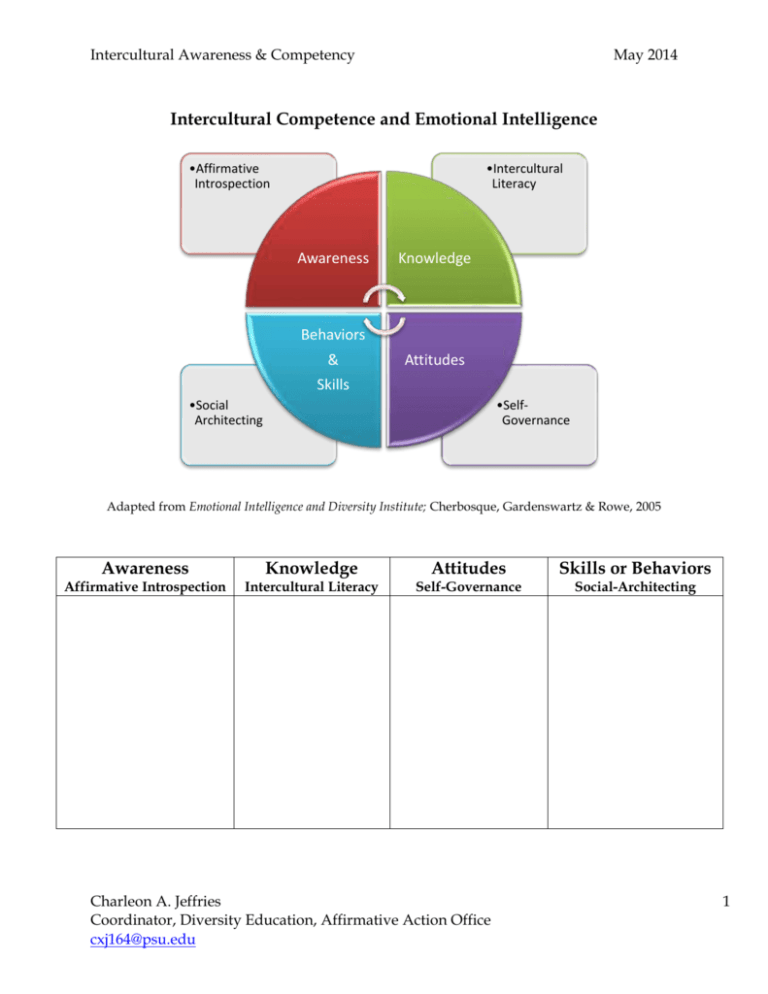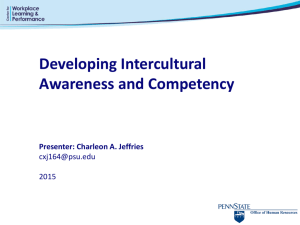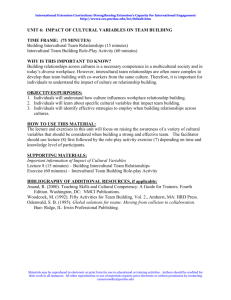Intercultural Competence and Emotional Intelligence
advertisement

Intercultural Awareness & Competency May 2014 Intercultural Competence and Emotional Intelligence •Affirmative Introspection •Intercultural Literacy Awareness Knowledge Behaviors & Attitudes Skills •Social Architecting •SelfGovernance Adapted from Emotional Intelligence and Diversity Institute; Cherbosque, Gardenswartz & Rowe, 2005 Awareness Knowledge Attitudes Skills or Behaviors Affirmative Introspection Intercultural Literacy Self-Governance Social-Architecting Charleon A. Jeffries Coordinator, Diversity Education, Affirmative Action Office cxj164@psu.edu 1 Intercultural Awareness & Competency May 2014 Dimensions of Diversity Adapted from Gardenswartz & Rowe, Diverse Teams at Work: Capitalizing on the Power of Diversity, SHRM (2003). Charleon A. Jeffries Coordinator, Diversity Education, Affirmative Action Office cxj164@psu.edu 2 Intercultural Awareness & Competency May 2014 Dimensions of You Using the Dimensions of Diversity choose the three aspects that are currently the most significant for you. For each aspect, list the impact it has had on your life and/or your work. Aspect: Impact on life/work: Aspect: Impact on life/work: Aspect: Impact on life/work: Charleon A. Jeffries Coordinator, Diversity Education, Affirmative Action Office cxj164@psu.edu 3 Intercultural Awareness & Competency May 2014 Mapping Your Cultural Orientation Individuals demonstrate a wide range of values and preferences across a variety of cultural dimensions. Map your own cultural orientation by placing an “X” at the spot that most accurately reflects your values on each continuum below. Remember that a continuum represents an infinite number of possibilities between the two opposing ends. There are no right or wrong answers. Monochronic…………….………………………….……………………………Polychronic I like to be on time and What happens is more important expect the same of others. than when it starts and ends. Low Context………………………….…………………………………………High Context When rules are presented, I prefer that every detail is spelled out clearly. Some rules are understood by everyone so it’s not necessary to spell everything out. Individualistic………………………………………………..............................Collectivistic I prefer to work independently and be recognized individually. I prefer to work as part of a group and think it’s better when individuals are not singled out. Egalitarian………………………………….………………………………………Hierarchical All people should be treated the same, no matter what their position is. People should be treated differently depending on their title, position, rank. Task Focused………………………………...…………………………Relationship Focused When working on a project, I prefer to focus on getting the job done and become impatient with socializing. When working on a project, I value time spent in building relationships and work better with people when I get to know them. Surfacing Differences………………..………………………………Maintaining Harmony I directly address differences when there is an issue so the problem can be solved quickly. I prefer to deal with differences indirectly, behind the scenes, to avoid causing upset. Emotionally Restrained…………………….………………………Emotionally Expressive It’s better to keep emotions private It’s better to express emotions openly Being……………………………………………………………………………………….Doing I derive more of my identity from who I am and who my family is I derive more of my identity from what I do: schoolwork, activities, etc. Charleon A. Jeffries Coordinator, Diversity Education, Affirmative Action Office cxj164@psu.edu 4 Intercultural Awareness & Competency May 2014 1. Challenge others on racial/ethnic/sexually derogatory comments? 2. Speak up when someone is humiliating another person or acting inappropriately? 3. Think about the impact of my comments and actions before I speak or act? 4. Refuse to participate in jokes that are derogatory to any group, culture or sex? 5. Refrain from repeating statements or rumors that reinforce prejudice or bias? 6. Check out reality before repeating or believing rumors or assumptions about anyone? 7. Recognize and challenge the biases that affect my own thinking? 8. Avoid using language that reinforces negative stereotypes? 9. Assume and convey the message that those different from the majority are as skilled and competent as others? 10. Get to know people from different cultures and groups as individuals? 11. Realize members of another culture have a need to socialize with and reinforce one another and connect as a group? 12. Accept and reinforce the fact that not everyone has to act or look a certain way to be successful in or valuable to my organization? 13. Take responsibility for helping new people in my organization feel welcome and accepted? 14. Include others different from myself in the informal networks and/or social events? 15. Learn about and appreciate the richness of other cultures and respect their holidays and events? 16. Ask for and attend social events in which all people are able to participate? 2 3 4 1 2 3 4 1 2 3 4 1 2 3 4 1 2 3 4 1 2 3 4 1 2 3 4 1 2 3 4 1 2 3 4 1 2 3 4 1 2 3 4 1 2 3 4 1 2 3 4 1 2 3 4 1 2 3 4 1 2 3 4 Almost Always Usually 1 Almost Never Seldom Diversity Awareness Profiles Page Total: _________ Charleon A. Jeffries Coordinator, Diversity Education, Affirmative Action Office cxj164@psu.edu 5 Charleon A. Jeffries Coordinator, Diversity Education, Affirmative Action Office cxj164@psu.edu 1 2 3 Almost Always Usually 17. Encourage underrepresented colleagues to speak out on their issues and concerns and treat those issues as valid? 18. Encourage underrepresented colleagues to take risks? 19. Listen to the ideas of others and give them credit, both one-on-one and in group meetings? 20. Include underrepresented colleagues in decisionmaking processes that affect them? 21. Empower underrepresented colleagues by handing over responsibility to them as often as I do to others? 22. Provide straightforward and timely feedback to those I work with? 23. Share the written and unwritten rules of my organization to those from different cultures? 24. Disregard physical characteristics when interacting with others and when making decisions about competence or ability? 25. Take responsibility for helping my organization meet legal (AA/EEO) guidelines? 26. Follow and reinforce organizational policies regarding equal treatment, including confronting others who violate those policies? 27. Consider underrepresented members, including women, for all opportunities and positions I have influence over? 28. Keep all others in the information loops, both formal and informal? 29. Help provide all employees with ample training and education to succeed in their jobs and to grow? 30. Provide formal and informal mentoring to new employees, including underrepresented colleagues, so they can “learn the ropes”? 31. Make the extra effort to help my organization retain underrepresented employees? 32. Reinforce others for behaviors that support cultural diversity? Seldom May 2014 Almost Never Intercultural Awareness & Competency 4 6 Intercultural Awareness & Competency May 2014 1 2 3 Almost Always Usually 33. Confront organizational policies and procedures that lead to the exclusion of anyone? 34. Do all I can to help create a work environment in which all employees are respected and valued? 35. Make extra efforts to educate myself about other cultures? 36. Call, write, or in some way protest when a book, newspaper, television show, or some branch of the media perpetuates or reinforces bias or prejudice? 37. Refuse to join or remain a member of associations or groups that allow or reinforce values or practices that are racist, biased, or prejudiced? 38. Participate in volunteer or community activities that are change agent efforts? 39. Make extra efforts to get to know individuals from diverse backgrounds? 40. Say “I think that’s inappropriate,” when I think some indicated prejudice? Seldom Almost Never Page Total: _________ 4 Page Total: _________ Charleon A. Jeffries Coordinator, Diversity Education, Affirmative Action Office cxj164@psu.edu 7 Intercultural Awareness & Competency May 2014 • Scores for naïve offenders vary greatly because these individuals have little concept of their Naive Offender impact on others. (0-40) Perpetuator (40-79) Avoider (80119) • These individuals recognize their biased attitudesand behaviors and subsequently reinforce the system of racism and prejudice because of their refusal to change. • These individuals recognize their biased behaviors but do not take a stand against unjust behaviors. • These individuals feel compelled to eradicate the system of racism and oppression by challenging forms of discrimination when they Change Agent (120-139) occur. Fighter (140 - 160) • Fighters confront various forms of racism and discrimination and are often perceived by others as annoying and antagonistic. (Stinson, 2007) Charleon A. Jeffries Coordinator, Diversity Education, Affirmative Action Office cxj164@psu.edu 8




